Trip Logs
Cruising Scandinavia & the Baltic Sea Trip Log: July 25–Aug 3, 2024
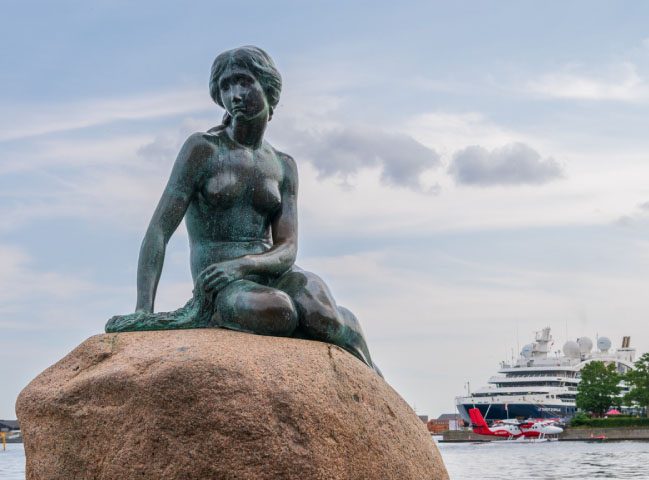
July 25, 2024 | Copenhagen, Denmark
Glorious blue skies and sunshine welcomed us to the “City of Spires.” After checking in with our Expedition Team, some of us relaxed in a hospitality suite. Others toured the city or explored the Nyhavn neighborhood with its colorful houses and Amsterdam-inspired canals. Here, author Hans Christian Andersen’s former home — the Boel House — overlooks the water.
In the afternoon, we took a leisurely, panoramic drive toward our ship, enjoying insight into Copenhagen's history and architecture provided en route. This included CopenHill, a combined heat and power waste-to-energy plant; the avant-garde Copenhagen Opera House; classical Amalienborg Palace; and Rococo-meets-Baroque Frederik's Church (the “Marble Church”). Across the river, we viewed the iconic Little Mermaid statue, popularized in a Hans Christian Andersen tale and now the symbol of Copenhagen. We also passed the impressive Gefion Fountain and the statue of a seated Andersen, his knees gleaming from seated photos with fans.
Arriving at the port, we boarded luxurious ‘Le Dumont-d'Urville.’ Having enjoyed welcome refreshments and arranged our cabins, we bid farewell to Copenhagen, set sail and sat down to dinner. Afterward, many of us lingered on the deck as we steamed toward Bornholm.
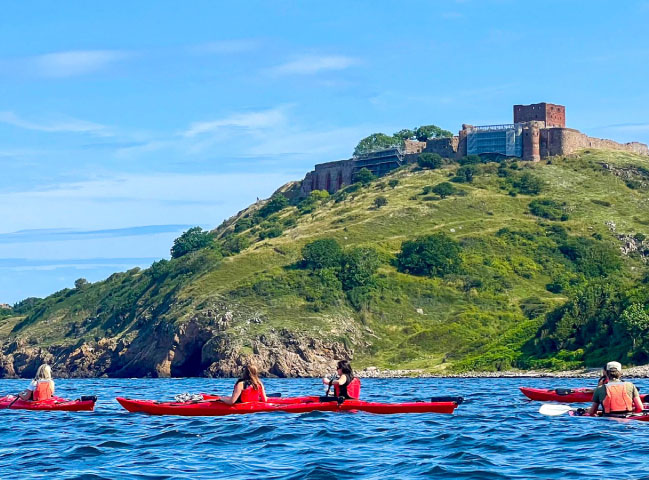
July 26, 2024 | Bornholm Island
Arriving in the picturesque harbor town of Gudhjem, we set out on our chosen adventures. Many visited the Hammershus Castle Ruins, set on a bluff high above the sea. Constructed in the 13th century, it served various purposes until 1743 when it was cannibalized for stone by the surrounding communities. We toured the granaries, chapel, residential precincts and dungeons — all offset by colorful wildflowers used during the Middle Ages for medicinal or culinary purposes.
Meanwhile, the paddlers among us explored the granite cliff face below the castle by kayak. We peeked into the “dry cave,” circumnavigated Camel Rock and journeyed to a razorbill rookery. Although the birds finished their breeding cycle and their young had already fledged, cormorants and gulls still perched high above.
Others explored the Østerlars Church, one of four round churches on the island. Beyond serving as places of worship, these defensive structures protected pirate incursions.
Those who strolled through the charming east coast town of Svaneke observed ochre-hued, thatched-roof buildings; windmills; a historic brewery; candy and ice cream shops; and artisanal glassblowing and blacksmith workshops. Returning to Gudhjem, some of us then strolled through the village, its lanes lined with multicolored hollyhocks.
Later, we took a coastal hike in Sandvig, heading toward the ruins of Solomon’s Chapel; encountering cows and deer; and taking in beautiful vistas along the way. Back aboard our vessel, we attended a photography talk. Later, we attended a welcome reception and met our ship’s officers.
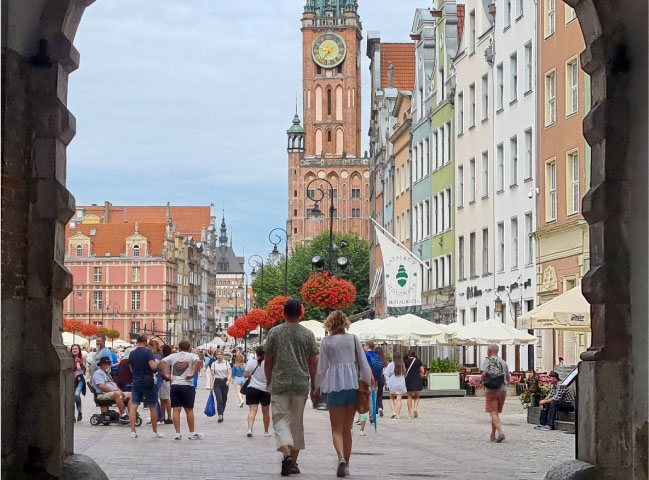
July 27, 2024 | Gdańsk, Poland
We arrived in Gdańsk, spoiled for choice when it came to tours. A significant Polish city with a pivotal role in the country’s history, Gdańsk was the epicenter of anti-government uprisings in 1970, which toppled communist leader Władysław Gomułka. A decade later, the Solidarity trade union movement emerged, marking the beginning of the end of communist rule. Led by Lech Wałęsa, Solidarity’s opposition paved the way for Poland’s democratic transition in 1989. Today, Gdańsk remains a major industrial and port city.
A group of us visited the European Solidarity Centre alongside our insightful guide. Others instead took a somber World War II remembrance tour to the Stutthof Concentration Camp, seeing the guard house, living areas, gas chambers and crematorium. A cheering, traditional Polish lunch followed. We ended the afternoon exploring the impressive Museum of the Second World War.
Still others ventured into the countryside, visiting Malbork Castle. The world’s largest castle by land area, it is also a UNESCO World Heritage Site. Built on the Nogat River in 1274 by the German Teutonic Order of Knights, the restored castle was heavily bombed during World War II. After a delicious local lunch in a small restaurant within the castle walls, we returned to our floating home.
The rest of our group strolled the streets of Gdańsk’s Old Town, pausing at the Golden Gate before taking in the Gothic and Baroque architecture. We saw the Artus Court; town hall; beautiful, mannerist-rococo Neptune Fountain; and brick, gothic St. Mary’s Church. We then wandered through Długi Targ (Long Market) and marveled at colorful costumed characters at the annual Festival of Wonders.
Returning to our ship, we set sail for Sweden. After our Captain shared engaging insight into the bridge, navigation and safety systems aboard ‘Le Dumont-d’Urville,’ we sat down to dinner. A lighthearted trivia night capped the day’s adventures.

July 28, 2024 | Gotland, Sweden
Some of us embarked on a scenic tour from Visby, a UNESCO World Heritage Site, first visiting a unique, ship-shaped grave dating back to 1100-400 BCE, one of many found on the island. We continued to the charming fishing village of Gnisvärd, known for its quaint cottages and beautiful seaside views. We then enjoyed a traditional Swedish snack, fika, with cinnamon buns. Returning to the walled city of Visby, we visited the Gotland Museum, learning about the island’s tempestuous history and viewing the Skillings Hoard, the world’s largest Viking silver treasure.
Those who stayed in Visby took a guided tour. We wound our way through the historic walls, past grand merchant homes and into the ruins of churches. We climbed the cathedral steps for breathtaking views and visited St. Mary’s Cathedral, home to a unique bee colony. We indulged in a local snack at a charming café within the botanical gardens. We then wandered at leisure as we worked our way back to the ship.
Those seeking a more active experience set off on a bike ride to Almedalen Park. We passed the Kruttornet (Powder Tower) and explored the botanical gardens. We then ventured into the picturesque countryside, encountering Gute sheep and enjoying stunning views of the limestone cliffs. Our cycling adventure culminated with a fika at Fridhem, the former summer residence of Princess Eugénie.
As the day drew to a close, we listened to a captivating presentation by our maritime archaeologist on the history of amber. We ended the day with a special cocktail hour featuring Spanish delicacies and planned future excursions.
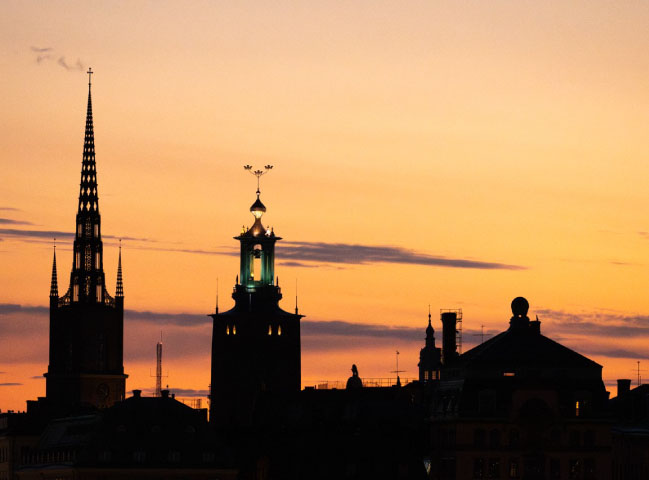
July 29, 2024 | Stockholm, Sweden
Mother Nature threw us a curveball — a swift-moving storm that closed the Port of Riga. Our team leaped into action, and we instead spent a windy — but sunny — day at sea, sailing along the west coast of the Baltic Sea.
Taking advantage of changed plans, we slept in and enjoyed a leisurely breakfast. We then joined our cultural geographer for a talk on the Vikings, their trade route and the Hanseatic League. After a coffee break, we met our photo coach for tips on smartphone photography.
In the afternoon, we threaded the myriad channels between the islands surrounding Stockholm, picking out our favorite waterside cottages and estates from the comfort of the observation lounge. Upon arrival in Stockholm, we quickly disembarked to explore the city or make dinner reservations.
The golden evening light illuminated the historic baroque and rococo buildings that lined the canals and Old City streets. Given the full day of activities planned for tomorrow, most of us headed to bed before the final shuttles ran.
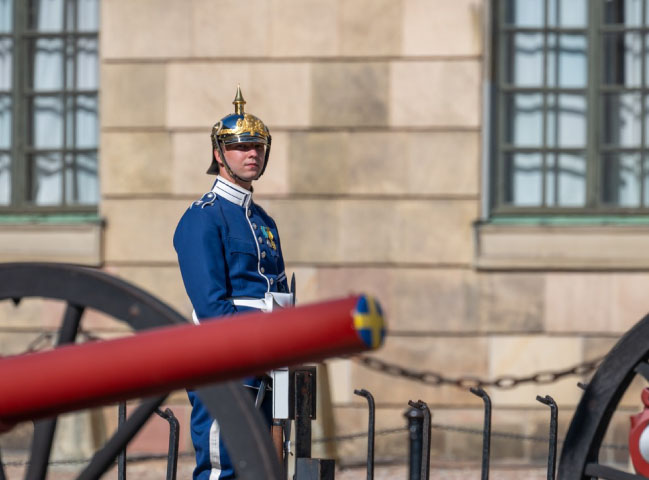
July 30, 2024 | Stockholm
Some of us were off bright and early for an excursion to Uppsala. After viewing the impressive Uppsala Cathedral, we paused in its coffee shop to enjoy hot, freshly baked cinnamon buns. After taking in panoramic views of the city, we proceeded to Sigtuna with its picturesque main street and wooden town hall.
Others hopped on e-bikes to explore Old Stockholm, passing the Royal Palace and following the waterfront to cross the Djurgårdsbron bridge. We then navigated the peaceful, lush island of Djurgården, home to many of Stockholm’s best-known museums. After pausing at a biodynamic garden café, we stepped inside ABBA The Museum for a self-guided tour. Ending the day, we sample local treats, including fika, princess cake and cinnamon buns paired with coffee.
Those who preferred a leisurely pace headed to Skansen, an open-air museum and zoo depicting the way of life in the different parts of Sweden before the industrial era. Capping the day on a sweet note, we too enjoyed a fika.
After lunch aboard our ship, some of us ventured to the Vasa Museum, which houses the world’s only preserved 17th-century warship. After learning about its history from our guide, we had time to explore at leisure. Others visited Drottningholm Palace, a UNESCO World Heritage Site and private residence of the Swedish royal family. We had the pleasure of observing a lighting rehearsal before strolling through its picturesque gardens.
Those who explored Old Stockholm on foot basked in the warm sunshine during a guided walking tour that passed beautiful, historic Storkyrkan, an old parish church. We then toured the Royal Palace with its opulent public spaces and stunning marble staircases. Naturally, we enjoyed a fika, this time in one of Stockholm’s oldest restaurants. Still others visited Stockholm City Hall, where the annual Nobel Prize banquet is held. After seeing the stunning Blue Hall and glittering Golden Hall, we indulged in high tea at the luxurious Grand Hôtel. The rest of us embarked on a Nordic food experience, meandering through Stockholm’s Old Town while sampling smoked reindeer, cured moose, bear sausage and herring, along with local beer and brännvin.
Returning to ‘Le Dumont-d’Urville,’ we sailed onward through the beautiful islands and took in an onboard dance performance.
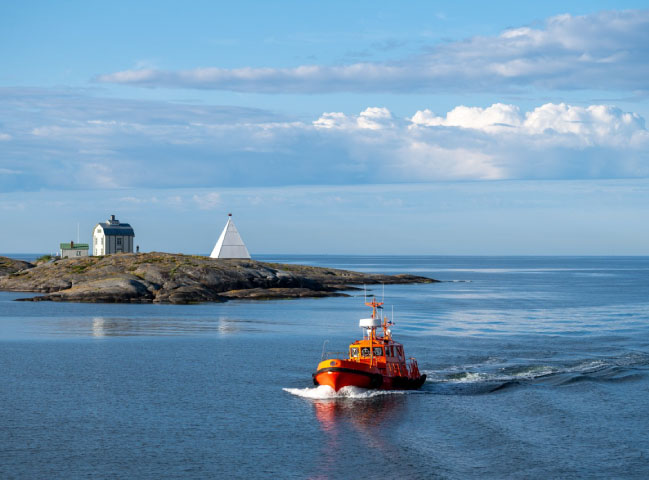
July 31, 2024 | Åland Islands, Finland
This morning’s temperatures were perfect for a cycling venture. After a tour through Mariehamn — the island’s largest town — we headed south to the Nåtö Nature Preserve, enjoying lovely views of coastal meadows and beautiful seaside homes. After a break with refreshments, we returned to town and had lunch aboard our vessel or on our own.
Others began a walking tour in the town garden, where a statue of Maria Alexandrina — the Russian Empress and town founder — stands. We visited the Parliament building of Åland, exploring its rooms and learning about the Åland archipelago before continuing to Torggatan, a pedestrian shopping street, where we saw an old, wooden pyramidal house that sheltered seamen. After admiring the town’s architecture — particularly buildings by Finnish architect Lars Sonck — our walk concluded with cinnamon buns and free time to shop for handicrafts and jewelry at a historic, converted shipyard.
Those who ventured further afield visited Friluftsmuseum Jan Karlsgården, an open-air museum that depicts farm life in the late 19th century. To refuel, we enjoyed a local specialty — an oven-baked, thick rice-based pancake topped with saucy, roasted plums and whipped cream. Refreshed, we explored the farmstead and were delighted to discover a craft festival in full swing. Costumed artisans spun and dyed yarn, wove cloth, tatted bobbin lace and made nine-strand rope. There were also rural crafts for sale, with proceeds benefiting charity.
Next, we visited the imposing, 14th-century Kastelholm Castle, seeing the dungeons once used for witch trials and as a prison. We envisioned a medieval banquet in the dining hall, tried on battle helmets and chain mail, and made our own heraldic shields. Naturally, the castle offered stunning views and photo opportunities from the battlements.
After we all returned to the ship for lunch, several shuttles were available for those interested in exploring the town center. Some of us also visited the nearby maritime museum, where we toured the Pommern, a four-masted iron-hulled sailing ship used by German shipping company F. Laeisz. It once transported grain from Australia to the U.K. and twice won the Great Grain Races in 1930 and 1937.
Tonight, as we sailed toward the Finnish capital, Helsinki, while enjoying a lovely piano concert in the theater.
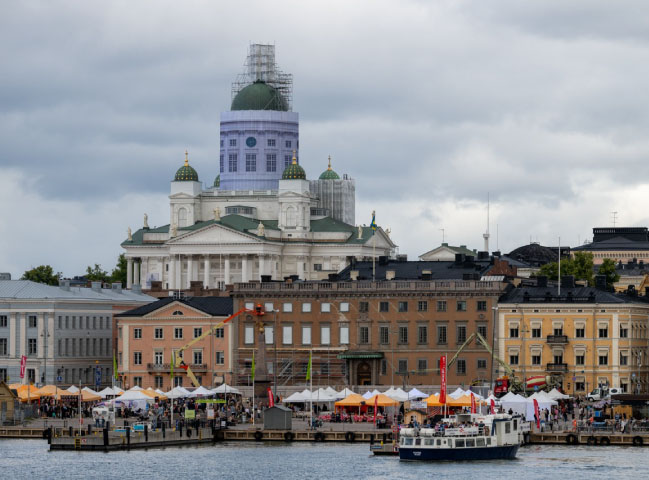
August 1, 2024 | Helsinki
It was a relaxing morning at sea. Our Captain opened the bridge for tours and two enriching presentations discussed the maritime archaeology of the “other Mediterranean” and the making of modern Europe.
Arriving in Helsinki, we set off to explore. Many of us passed through the beautiful landscape until we reached the picturesque town of Porvoo, known for its historic, ochre-red-painted warehouses lining the river. We explored on foot, either enjoying time at leisure or visiting Porvoo Cathedral. We then regrouped and embarked on a private, guided boat ride in Porvoo, indulging in a Finnish tart en route.
Others boarded a private vessel, cruising through the islands while snacking on the region’s traditional cinnamon buns. Docking at the 17th-century Suomenlinna Sea Fortress — a UNESCO World Heritage Site — we joined our guides on a walking tour or wandered on our own. Covering 518 acres and consisting of 200 buildings and nearly four miles of defensive walls, the fortress stretches over six separate islands. We viewed the commandant’s house; several memorials; the dry dock; cannons and their ammunition stores; and the barnacle geese.
Those staying closer to the city set out on a drive, passing the Embassy; Senate Square with its neoclassical Lutheran cathedral; the Parliament House; the National Museum of Finland; the 1952 summer Olympic stadium; and the avant-garde Finlandia Hall, designed by Finnish architect Alvar Aalto. Temppeliaukio Church, a Lutheran rock church, was among the highlights.
Back aboard our ship. we enjoyed a live, Finnish musical performance featuring works by Jean Sibelius and set sail for Estonia.
August 2, 2024 | Tallinn, Estonia
Tallinn, Estonia’s capital, boasts a rich and turbulent history shaped by diverse rulers. From the Danes and Hanseatic League to the Swedes and Russians, each left an indelible mark on the city’s character. In the past quarter-century, Tallinn has transformed into a vibrant and stylish destination, seamlessly blending its medieval heritage with modern allure. This remarkable fusion earned it prestigious recognition as a UNESCO World Heritage Center.
We began our walking tour by admiring the vibrant pink façade of Toompea Castle and the adjacent Parliament House. After taking in the serene castle garden, we crossed the street to witness a service at the magnificent Alexander Nevsky Cathedral. Next, we climbed to an observation deck for a panoramic view of the city before returning to the heart of the action, Town Hall Square. Here, we learned about the history of the Lower Old Town and indulged in a delicious lunch at a local restaurant, sampling game sausage, pickles and local beers. Our exploration continued with a visit to an ancient apothecary, established in 1422 and still operating today. Finally, we made our way through the ivy-covered Viru Gate and past the bustling flower market to catch our shuttle back to the ship.
Those seeking a natural escape journeyed to Pohja-Korvemaa Nature Preserve, where they donned rubber boots and snowshoe-like devices to navigate the boggy terrain. A guide led them through the Kakerdaja bog and onto a boardwalk, using a GPS to ensure they didn’t get lost. Along the way, they admired plants showcasing early autumn colors and spotted rare species like the carnivorous sundew. The walk culminated in a delightful feast of fresh and natural treats, including fresh cepe mushrooms, mushroom pâté, grilled zucchini, bread and beets. Returning to the city, they had time to catch a shuttle to the Old Town.
Those exploring Lahemaa National Park in northern Estonia discovered the region’s rich history and culture. We visited the stunning Baroque Palmse Manor, which — along with its surrounding parks and gardens — forms a captivating open-air museum. We conveniently explored the area using golf carts.
Our adventure continued at the Vihula Manor Vodka Museum, where we learned about Estonia’s vodka heritage, local distilleries, and the distillation process. We each had the opportunity to sample four unique vodkas, a tradition in Estonian culture. Some of the flavors we tried included pepper and apple, while another was made from barley instead of the usual potatoes. We also enjoyed some free time to explore the charming Old Town.
Upon returning to the ship, we attended a caviar reception hosted by our Captain, who then introduced us to the entire crew and officers. Before heading to the farewell dinner, we gathered in the theater to enjoy a slideshow and music, diligently created throughout our voyage. As we dined, we arrived in Helsinki. Afterward, those not preoccupied with packing headed to the main lounge for trivia. This lighthearted activity served as a prelude to the final preparations for disembarkation the following day.
 The Americas
The Americas Europe, Middle East and Africa
Europe, Middle East and Africa Australia, NZ and Asia
Australia, NZ and Asia































































































































































































































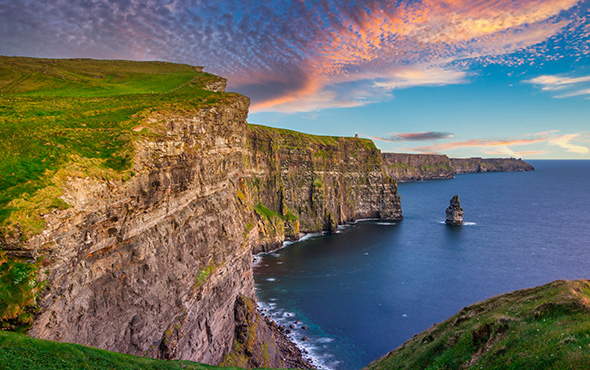




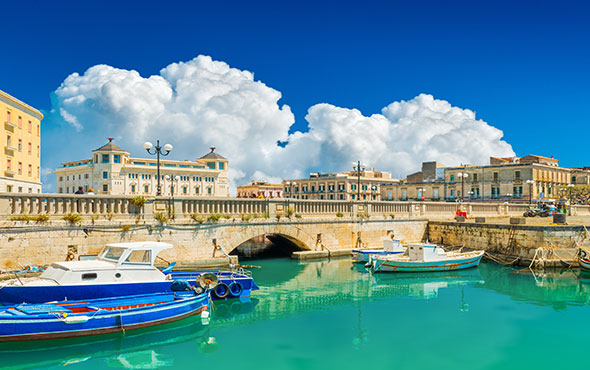



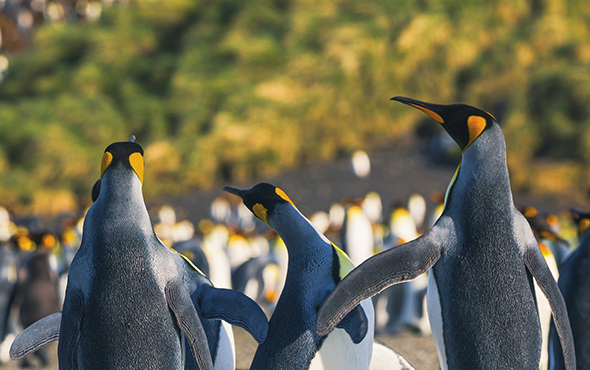
 The Americas
The Americas
 Europe, Middle East and Africa
Europe, Middle East and Africa Australia, NZ and Asia
Australia, NZ and Asia